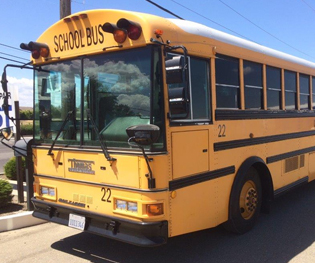What school buses are already in compliance with this regulation?
School buses with ARB-verified Level 3 (85 percent reduction of PM) particulate filters installed or
engines meeting a 0.01 grams/brake horse power-hour PM emission standard and school buses
with ARB-verified Level 2 (50 percent reduction of PM) particulate filters installed on or before
December 31, 2005, if that was the highest level device available at the time.
What school buses are exempt from the regulation?
School buses with a GVWR less than or equal to 14,000 pounds, school buses registered as historic
vehicles and non diesel-fueled school buses such as compressed natural gas fueled school buses
are exempt.
Is there a provision for low use school buses?
Yes. School buses operating less than 1,000 miles in a 12-month period are exempt from the
performance requirements of the regulation; however, these vehicles are subject to recordkeeping
requirements.
What is required if a school bus cannot be retrofitted?
A delayed compliance date of January 1, 2018, is provided for school buses that cannot be
retrofitted (e.g., 2-stroke engine buses and some pre-1987 model year school buses). By January 1,
2018, these buses must be replaced if no particulate filter is available or repowered with an engine
on which a particulate filter can be installed. Recordkeeping and reporting requirements apply until
the school bus is brought into compliance.
What are the reporting requirements?
Reporting is required when the owner of the fleet chooses to use the “Extension of Deadline for
Unavailability of Verified Diesel Emission Control Strategy,” which applies to buses on which a PM
filter cannot be installed. The reporting requirements apply on January 31 of each compliance year
through January 31, 2017. These buses are also subject to recordkeeping requirements.
Are there credits for fleets that have downsized?
Yes, there are credits for downsized fleets until January 1, 2014. A fleet that decreases their number
of regulated school buses may reduce the percent requirement in Table 1 by the same percentage
that the fleet has downsized since 2006. For example, a fleet that is 20 percent smaller than it was
in 2006 would subtract 20 percent from the annual compliance requirement. If the compliance
requirement for the year is 33 percent, the fleet would need to demonstrate that it had PM filters
on 13 percent of the existing fleet (33 percent - 20 percent = 13 percent). All school buses in the
2006 baseline fleet and in the fleet on January 1st of the compliance year are subject to the
recordkeeping requirements.
Are there credits for fleets with alternative-fuel vehicles?
Yes. Fleets with electric, hybrid, alternative fuel or pilot ignition engine school buses with a GVWR
greater than 14,000 pounds shall receive a credit to treat a diesel school bus as compliant until
January 1, 2014.
When is a California Highway Patrol safety inspection required?
The CHP safety inspection is required after a PM filter is installed and before the school bus
returns to service.
How have retrofits on school buses performed?
Retrofit PM filters have proven to be a cost-effective option for school buses. Thousands of filters
have already been installed on school buses throughout the state, with fewer than one percent
exhibiting issues. When issues have arisen, PM filter manufacturers have worked with fleets to
resolve them.
How are retrofits a cost-effective approach for reducing PM emissions?
Approximately seven school buses can be retrofitted for the same amount of money as one new
school bus replacement. A PM filter costs less than a new bus even when considering the added
cost of infrastructure and electricity. Also, fleets will incur maintenance costs regardless of whether
an aftermarket filter or an original engine manufacturer filter is installed on the school bus.
Is incentive money available?
The Lower-Emission School Bus Program provides limited financial incentives of up to $20,000 per
bus to install diesel PM filters and up to $140,000 per bus to help replace high-emitting pre-1987
model year buses (match funding is required to replace 1977-1986 model year buses) to reduce
toxic PM emissions. The use of fully-funded diesel PM filters substantially reduces school children’s
exposure to toxic diesel PM and is the least expensive compliance option.
This funding does not cover the cost of a typical hybrid school bus. The Hybrid Truck and Bus
Voucher Incentive program permits combining funds from the Lower-Emission School Bus
Program to finance up to the full cost of a new hybrid school bus. Additionally, many local air
districts collect motor vehicle registration fees and other funds which may be used to replace
or retrofit school buses. Information about the LESB program is located at
www.arb.ca.gov/bonds/schoolbus/schoolbus.htm.
For More Information
Fact sheets, compliance tools and regulatory documents are available at
www.arb.ca.gov/dieseltruck
or by calling ARB’s diesel hotline at (866) 6DIESEL (634-3735).
To obtain this document in an alternative format or language please contact the ARB’s Helpline
at (800) 242-4450 or at
helpline@arb.ca.gov
. TTY/TDD/ Speech to Speech users may dial 711
for the California Relay Service.




